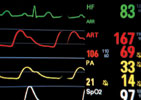

Securing Steve Biko Academic Hospital.
Local converged network provider and electronic security technology specialist, KSS Technologies (KSS), is busy implementing a complete integrated security systems at the Steve Biko Academic Hospital.
With close to a million patients a year, there was previously no electronic access control and security system in the hospital, and the booms at the gates were controlled manually. More importantly, there was no reliable way of monitoring or controlling staff attendance or monitoring their physical working hours.
The hospital is a 10 storey facility with more than 800 beds and close to 4500 staff. It has 16 access points with six accessible by motor vehicles.
KSS sales manager, Stuart Cohen says the hospital was without a functional access control and operational security system. “Few areas of the hospital had closed circuit TV (CCTV) cameras and we were told that the cameras were obsolete and the company that fitted them in the early 2000’s had dissolved.”
The proposed integrated solution needed to include access control, time and attendance, CCTV, patient tracking, fire alarm and the tagging and tracking of assets. The new system with integrated time and attendance is a total access control system for the monitoring and controlling of the exterior perimeter (fences), interior perimeter (parking areas), gates, booms, turnstiles at entrances, doors, lifts and restricted areas of the hospital. It makes use of both biometrics, magnetic and proximity card readers.
Access control
The exterior perimeter fences are monitored by the latest security technology alerting the control room in case of a security breach. Furthermore, all perimeter gates are electric gates or electric booms linked to access control units.
Cohen says public parking areas now make use of a biometrics solution, photographing driver, capturing and linking vehicle registration number to ticket issued upon entering the hospital premises. “The driver and vehicle is now verified when exiting the hospital. In order to prevent queuing at the staff parking areas, proximity staff cards are used to activate boom gates. The vehicle registration number and staff card is linked and verified upon entering and when exiting.”
In addition, the main entrance and other identified areas have an electronic sliding door for wheelchair and trolley patients. These are controlled by a security officer once biometric samples are obtained to avoid tailgating.
Staff members are now registered on the time and attendance system at point of entry or exit, their access is verified by proximity staff ID cards and a matching biometric sample. The proximity staff ID must also now be used to activate lifts to access restricted floors.
Surveillance implemented
A fully manageable CCTV system was installed to monitor all critical areas including parking areas, access gates, passages, lifts, lobbies, delivery areas, restricted areas and store rooms. All cameras have day and night vision capability and use the latest hard disk recording technology.
Cohen says the system allows for a pre-determined recording time and selected recordings can be extracted and copied in the case of a security event. “The system is able to do motion, scheduled and live recording in identified areas. The CCTV system is able to link into the access control and asset tracking systems in order to enable video tracking of security breaches and foul play events.”
The patient tracking system allows for all patients admitted to the hospital to be tagged with an RF-ID wristband. This can then be used to verify that the correct patient is receiving the correct medical treatment, especially in operating theatres. It can also be used as a baby alarm in neonatal and paediatric areas. Patients can also be monitored and controlled for leaving the hospital without permission.
For more information contact KSS Technologies, +27 (0)11 545 6306, [email protected]
© Technews Publishing (Pty) Ltd. | All Rights Reserved.